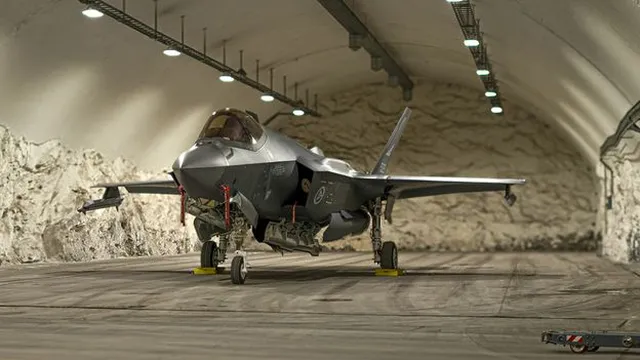
Norway reactivates Cold War bunkers amid rising Russian threats
2025-04-01 19:06- Norway has begun reactivating Cold War military bunkers at Bardufoss Air Station and Olavsvern naval base due to heightened Russian aggression.
- Upgrades to these facilities are intended to bolster the resilience of Norway's F-35 fighter jets and increase military readiness.
- The reactivation reflects a strategic response to Russian military activities in the Arctic and may influence defense strategies of NATO allies.
Express your sentiment!
Insights
Norway, situated close to the Russian border, has initiated the reactivation of two significant Cold War-era military bunkers as concerns about Russian aggression escalate. These bunkers, particularly at Bardufoss Air Station and Olavsvern naval base, have undergone various upgrades to enhance their capabilities and support the Norwegian Air Force's F-35 fighter jets. The urgency for these enhancements stems from recent conflicts, particularly the Russian invasion of Ukraine, which has highlighted the vulnerabilities of modern military aircraft when stationed on the ground. As tensions continue to rise in the region, Norway's government is prioritizing the resilience of its military infrastructure. The Cold War bunkers were originally constructed in response to the geopolitical threats posed by the Soviet Union, however, with the dissolution of the USSR, their significance diminished over time. Today, however, the changing landscape of international relations, including increased military exercises by Russia in the Arctic and its strategic interests in the region, have led to a resurgence in the importance of these facilities. Experts believe that maintaining a robust military presence in northern Norway is essential for national security, especially in light of recent military investments by Russia. Norwegian authorities are also collaborating with international partners like the United States, which is exploring options to base its nuclear submarines at the reactivated sites. This partnership underscores the enhanced military cooperation in response to the evolving threats posed by Russia. As Norway modernizes its Cold War-era military structures, it raises questions about defense strategies among NATO countries and whether they will follow suit in reactivating their own underground facilities. Despite the benefits of reactivating these military sites, challenges remain, particularly concerning the costs and security of previously deactivated locations. If long-decommissioned facilities have been compromised by foreign intelligence, their operational integrity is questioned. Experts suggest that investing in underground structures, like bunkers, can help shield military assets from aerial attacks. Nevertheless, the financial burden may deter other nations from considering similar moves, given the historical tendency to repurpose such sites for civilian uses, such as museums or nightclubs.
Contexts
The impact of the Russian invasion on Nordic countries is multifaceted, affecting security, economy, and political governance in the region. Following the invasion, Nordic countries have experienced heightened security concerns due to their proximity to Russia. Sweden and Finland, which have historically maintained a policy of military non-alignment, have reevaluated their stance and sought closer ties with NATO. The prospect of NATO membership has gained significant support in both countries, particularly as the threat of Russian aggression looms. Furthermore, joint military exercises among Nordic countries have intensified, promoting collaborative defense measures aimed at countering potential threats from the east while fostering regional unity and resilience against possible incursions or hostilities from Russia. This security shift underscores a pivotal transformation in the strategic landscape of Northern Europe, whereby defense spending is likely to increase to bolster national armies and improve military capabilities in response to the invasion. Economically, the invasion has disrupted trade dynamics and created market uncertainty in the Nordic region. Energy security has become a primary concern, especially as countries strive to reduce their dependence on Russian energy supplies. This drive has led to increased investments in renewable energy sources and greater exploration of alternative gas and oil suppliers. The Nordic countries have also taken actions to support sanctions against Russia, further isolating it economically and politically. As a result, trade relations with Russia have been strained, prompting countries like Norway, which has ties through its oil and gas exports, to reevaluate their economic dependencies and push to secure more stable and reliable supply chains. Subsequently, the transition to diversification of energy sources is likely to gain momentum, fueling innovation and collaboration within the sector. Politically, the invasion has triggered a wave of solidarity among the Nordic countries, reaffirming their commitment to collective security and shared democratic values. Not only has this situation influenced domestic policies, but it has also encouraged these nations to adopt a more proactive stance in international forums. The Nordic Council has become more relevant in addressing these new security challenges, facilitating discussions on coordinated responses and potential initiatives to enhance regional stability. Furthermore, the invasion has led to increased public awareness regarding national and international security issues, prompting citizens to engage more in political discourse surrounding defense and foreign policy matters. As this situation evolves, the long-term ramifications of Russia's military aggression may redefine the geopolitical landscape of Northern Europe. The Nordic countries are likely to continue adapting their foreign and defense policies, focusing on enhancing security cooperation both regionally and globally. The trend toward stronger integration with NATO and increasing military readiness reflects a broader recognition of the need to ensure peace and stability within a changing security environment. Ultimately, the Russian invasion has accelerated shifts in the Nordic security paradigm, posing new challenges and opportunities for the region as it navigates the complexities of its relationship with Russia while seeking to uphold democratic principles and regional stability.